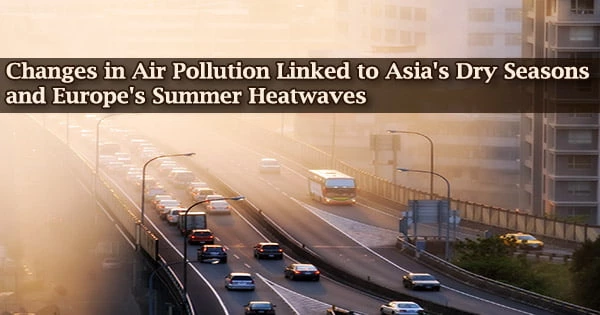According to new research, air pollution rises in Southeast Asia, paired with pollution reductions in Europe, may have had a significant impact on European and Asian weather patterns in recent decades.
A mixture of solid particles and gases in the air is referred to as air pollution. Particles may be suspended as a result of automobile emissions, factory chemicals, dust, pollen, and mold spores. Ozone, a gas, is a key contributor to urban air pollution. Smog is the term for air pollution caused by ozone.
Changes in air pollution levels in the two regions were likely the primary driving force behind changing atmospheric conditions that favored prolonged summer extremes in Europe and caused dry spells in Central Asia, according to scientists at the University of Reading’s analysis of weather records and climate models.
Every year, an estimated seven million people die as a result of air pollution around the world. According to data from the World Health Organization (WHO), almost all of the world’s population (99%) breathes air that exceeds WHO guideline limits and contains high amounts of pollutants, with low and middle-income countries suffering the most. The World Health Organization (WHO) is assisting countries in combating air pollution.
According to new research published in Nature Communications, air pollution increases between 1979 and 2019 reduced the temperature differential between the two locations, weakening the jet stream over Asia significantly.
These high-altitude winds have a significant impact on atmospheric circulation in the Northern Hemisphere and help to define weather in Europe and other mid-latitude regions.
The research counters previous suggestions that the weakening of the summer jet stream was the result of rapid warming in the Arctic due to greenhouse gas emissions. It highlights another significant role human activity plays in driving extreme weather over vast regions.
Dr. Buwen Dong
Dr. Buwen Dong, an NCAS scientist at the University of Reading, said: “Our findings suggest changes to air pollution had a greater influence on Northern Hemisphere summer weather than we thought.”
“The research counters previous suggestions that the weakening of the summer jet stream was the result of rapid warming in the Arctic due to greenhouse gas emissions. It highlights another significant role human activity plays in driving extreme weather over vast regions.”
Because pollution particles hinder heat from the sun from getting to the ground, air pollution is known to have a direct impact on surface temperatures. Air pollution is a huge hazard to health and the environment, from haze hanging over cities to smoke within the home.
Millions of people die prematurely each year as a result of the combined impacts of ambient (outside) and domestic air pollution, primarily as a result of increased mortality from stroke, heart disease, chronic obstructive pulmonary disease, lung cancer, and acute respiratory infections.
Pollution increases in China and other parts of South and East Asia over the last 40 years have resulted in lower surface temperatures, whereas pollution reductions in Europe have resulted in clearer skies and warmer temperatures.
Temperature changes at different latitudes lowered vertical wind shear, weakening the summertime Eurasian subtropical westerly jet a ribbon of wind that stretches east from the North Atlantic Jet Stream into Central Asia and northern China by 7% over the timeframe.
The researchers looked at the effects of greenhouse gases and pollution particles individually and discovered that the former really causes the jet stream to strengthen, but that the latter is swamped by air pollution’s effects.
Dr. Dong said: “As South East Asian countries fulfill commitments to cut their air pollution levels over the coming decades, we would expect to see the jet stream strengthen over Eurasia once again, potentially reducing the likelihood of prolonged heatwaves but increasing the likelihood of strong cyclones in mid-latitudes.”
















